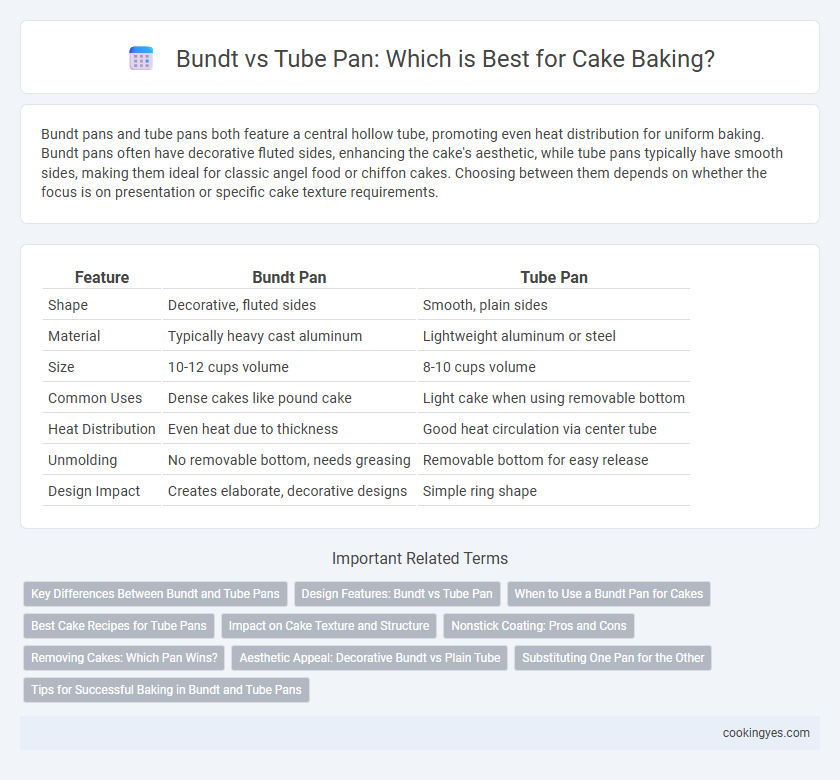Bundt pans and tube pans both feature a central hollow tube, promoting even heat distribution for uniform baking. Bundt pans often have decorative fluted sides, enhancing the cake's aesthetic, while tube pans typically have smooth sides, making them ideal for classic angel food or chiffon cakes. Choosing between them depends on whether the focus is on presentation or specific cake texture requirements.
Table of Comparison
| Feature | Bundt Pan | Tube Pan |
|---|---|---|
| Shape | Decorative, fluted sides | Smooth, plain sides |
| Material | Typically heavy cast aluminum | Lightweight aluminum or steel |
| Size | 10-12 cups volume | 8-10 cups volume |
| Common Uses | Dense cakes like pound cake | Light cake when using removable bottom |
| Heat Distribution | Even heat due to thickness | Good heat circulation via center tube |
| Unmolding | No removable bottom, needs greasing | Removable bottom for easy release |
| Design Impact | Creates elaborate, decorative designs | Simple ring shape |
Key Differences Between Bundt and Tube Pans
Bundt pans feature intricate designs with fluted or grooved sides, creating decorative cakes, while tube pans have smooth, straight sides for uniform baking. Both pans include a central tube that promotes even heat distribution, but Bundt pans often have a larger volume and are heavier, resulting in denser cakes. The nonstick surface of Bundt pans differs from the often lighter aluminum tube pans, impacting cake release and texture.
Design Features: Bundt vs Tube Pan
Bundt pans feature intricate, decorative designs with fluted or grooved sides that create visually appealing cakes, while tube pans have smooth, straight sides designed for even heat distribution and easy cake release. The central tube in both pans ensures the cake bakes from the center out, promoting uniform cooking, but Bundt pans often have thicker walls for denser batter types. Tube pans typically come with removable bottoms, facilitating simple removal of delicate cakes like angel food or chiffon cakes without damaging their shape.
When to Use a Bundt Pan for Cakes
A Bundt pan is ideal for dense, moist cakes like pound cakes or coffee cakes that benefit from even heat distribution and decorative edges. Its fluted design increases surface area, enhancing caramelization and creating a visually striking presentation. Use a Bundt pan when baking recipes requiring sturdy structure and intricate shapes that hold detailed designs.
Best Cake Recipes for Tube Pans
Tube pans excel in baking dense, moist cakes like classic pound cakes and angel food cakes, where the central tube ensures even heat distribution and proper rising. Recipes optimized for tube pans often emphasize light, airy textures with batters that benefit from the pan's design, such as chiffon and sponge cakes. Choosing a tube pan for these recipes enhances crumb structure and prevents undercooked centers, delivering perfectly baked results every time.
Impact on Cake Texture and Structure
Bundt pans, with their intricate designs and thicker walls, promote even heat distribution, resulting in cakes with a denser crumb and decorative crust. Tube pans feature a central chimney that improves heat flow, fostering a lighter, airier texture ideal for angel food and sponge cakes. The pan choice directly influences moisture retention and crumb firmness, shaping the overall cake structure and mouthfeel.
Nonstick Coating: Pros and Cons
Nonstick coating on Bundt and tube pans allows for easy release of intricate cake designs, minimizing the risk of sticking and breakage. While the coating enhances cleanup and preserves the pan's surface, it can wear off over time, especially with frequent use or abrasive cleaning methods. Choosing a high-quality nonstick pan extends durability but requires gentle handling to maintain its release properties and ensure consistent baking results.
Removing Cakes: Which Pan Wins?
Bundt pans feature intricate designs with a non-stick surface, facilitating easier cake release and visually appealing results, while tube pans often require loosening edges with a knife and sometimes greasing to prevent sticking. Cake removal from a Bundt pan is typically smoother due to its fluted sides and center tube that supports even baking and structural integrity. Tube pans excel in producing delicate angel food or chiffon cakes but may pose challenges in removing cakes without damage compared to the more user-friendly Bundt pan design.
Aesthetic Appeal: Decorative Bundt vs Plain Tube
Bundt pans create visually stunning cakes with intricate, decorative designs that enhance the overall presentation, making them ideal for special occasions and elegant desserts. Tube pans, in contrast, offer a simpler, plain appearance with smooth sides and a central tube, prioritizing even baking over ornamental detail. The choice between Bundt and tube pans significantly influences the cake's aesthetic appeal, as Bundt cakes often serve as a centerpiece while tube pan cakes function as a versatile, understated base for various toppings.
Substituting One Pan for the Other
Bundt and tube pans differ primarily in design; Bundt pans feature decorative fluted sides, while tube pans have smooth, cylindrical centers. When substituting one for the other, consider that Bundt pans typically hold more batter, affecting baking time and texture. Adjust oven temperature and baking duration to prevent undercooking or over-browning when swapping these pans.
Tips for Successful Baking in Bundt and Tube Pans
Bundt and tube pans require thorough greasing and flouring to ensure cakes release cleanly without tearing. Use a sturdy batter to prevent sinking, and ensure even oven heat distribution by placing pans in the center rack away from direct heat. Cooling cakes upside down in their pans preserves shape and texture, critical for the intricate designs of Bundt cakes and the tall structure of tube cakes.
Bundt vs Tube Pan for Cake Baking Infographic

 cookingyes.com
cookingyes.com